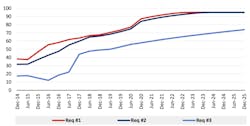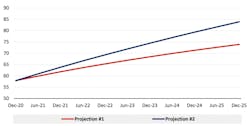Does robust fixed broadband competition quash a need for federal oversight?
ACA Connects (ACAC) has now released an in-depth study of the U.S. broadband market declaring that the vast majority of Americans now enjoy the fruits of robust broadband competition, and that the competitive market will further expand and intensify in the next several years. The study finds that a substantial majority of U.S. households have access to multiple broadband providers offering robust fixed service, and the competitive market will further grow and become more intense in the next three years.
The research further states that the percentage of U.S. households with a choice of such providers has increased dramatically since 2014; and that of the limited number of households without access to multiple providers, most have or soon will have access to a provider of robust, fixed broadband service whose service is subsidized by government funding, and whose prices and other terms of service are subject to regulatory oversight. As a result, the study concludes that whatever case there may have been to impose common-carrier style regulation on fixed broadband providers has vanished, especially for smaller providers.
ACA Connects president and CEO Grant Spellmeyer commented, “After decades of investment by multiple fixed broadband providers in every local market – amounting to well over $1 trillion during that time – the vast majority of American consumers now have a choice of broadband providers offering robust, reliable, fixed broadband service. And the reach and intensity of competition will only increase as broadband providers continue to invest many tens of billions of dollars annually."
ACAC represents approximately 500 smaller, independent broadband providers. The association contends that the new study demonstrates that a substantial majority of U.S. households have a choice of fixed broadband providers today, with more than 90% of households having access to at least one broadband provider offering 100/20+ service and at least one additional provider offering 25/3+ service. The study also shows that by 2025, 74% of all households will have access to at least two broadband providers both offering 100/20+ service.
Spellmeyer continued, “The federal government has established a two-prong approach for bringing fast and reliable fixed broadband service to all Americans: enable and encourage entry and competition in a light-touch regulatory environment; and, where the economics are too challenging, subsidize and regulate the provision of service. After two decades, the results are now in. We have developed in the United States a broadband infrastructure that is robust, reliable, and competitive because of the combined efforts of the private and public sectors. Working together, the two sectors are making great strides in closing the broadband availability and adoption gaps that remain."
The study adds that these projections, which are based solely on historic data, are conservative, given the announced plans of major incumbent telecommunications providers to dramatically accelerate the pace of their investments in fiber-to-the-premises (FTTP ) infrastructure over the next five years. Taking these already-announced plans into account, the study projects that approximately 84% of all households will have access to at least two providers offering 100/20+ service by end-of-year 2025.
ACAC said the study additionally demonstrates that for households where multiple providers may not be present, a significant share is already served, or soon will be, by a provider receiving deployment subsidies that subject the provider’s rates, terms, and conditions to government oversight. ACAC says that nearly 7% of U.S. households fall into this category today, and that percentage will increase significantly over the next few years as states begin to distribute funds provided under the Broadband Equity Access and Deployment (BEAD) program and various broadband programs funded by federal stimulus laws continue to gain traction. ACAC contends the study's findings show that broadband competition is already widespread and will continue to strengthen, thus benefiting consumers and eliminating any need to impose regulations restricting providers’ prices, terms, and conditions, which would cause harm without any gain.
“Given that competition is widespread and thriving, and government has already ample regulatory authority to protect consumers where competition is lacking, there is no justification to impose additional heavy-hand common-carrier-style regulation on fixed broadband providers as a whole,” said Spellmeyer. "Doing so would yield few, if any, tangible benefits but would discourage entry, investment, and innovation, to the detriment of consumers. However, even if new regulation were to be imposed on larger providers, there is a strong case for exempting smaller providers from any such regulation.”

